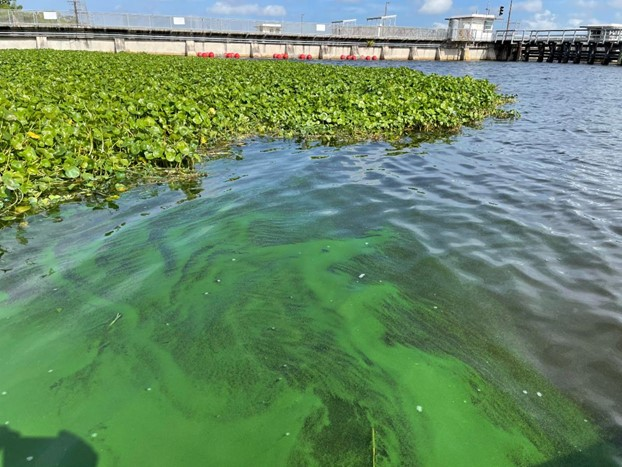Cyanobacteria, also known as blue-green algae, are diverse photosynthetic bacteria that play a crucial role in Earth’s ecosystems. These photosynthetic bacteria are pivotal in our environment, contributing to oxygen production and soil enrichment. However, in specific conditions, cyanobacteria growth can result in harmful algae blooms (HABs) that disrupt aquatic life and pose health risks to humans. This blog explores the significance of cyanobacteria, their vertical migration patterns, and how EEMS 12 can help manage and mitigate their impact.
The Importance of Cyanobacteria
Cyanobacteria are found in various habitats, from freshwater lakes to marine environments and terrestrial ecosystems. Through photosynthesis, they harness sunlight and carbon dioxide to produce organic matter, significantly boosting atmospheric oxygen levels. These remarkable microorganisms also fix atmospheric nitrogen, enhancing soil fertility and supporting other organisms’ growth.

Vertical Migration: Specialized Adaptation and Consequences
Certain cyanobacteria species exhibit vertical migration in water columns, such as Microcystis aeruginosa, Oscillatoria agardhii, and Anabaena flos-aqua. This behavior allows them to access light-rich surface layers for photosynthesis and nutrient-rich lower layers for sustenance.
However, under specific circumstances, cyanobacteria lose this vertical stability, leading to the formation of HABs. These blooms diminish sunlight penetration, deplete oxygen levels, and harm aquatic life. Moreover, some cyanobacteria produce toxic cyanotoxins that can contaminate water supplies, posing health risks like liver damage, skin irritation, and neurological effects.
Enhancing Your Water Quality Simulation Using Vertical Migration in EEMS 12
EEMS12 introduces a new feature for simulating algae vertical migration to help researchers and environmentalists manage and mitigate cyanobacteria-related issues. This powerful tool offers four options to specify the settling velocity of cyanobacteria and any other algal species for the vertical migration modeling:
- Constant Velocity: The first approach simply assumes that the algae migrate vertically with a constant settling velocity independent of time and location. The constant settling velocity (m/day) needs to be defined by a user as a model input parameter (Figure 2).
- Daily Cycle Velocity: The second approach assumes that the algae migrate vertically on a daily cycle, representing the variations in buoyancy of cyanobacteria colonies driven by changes in light intensity, based on Overman et al. (2022) (Figure 3).
- Daily Cycle Velocity with Depth-varying Light Effects: The third approach extends the daily cycle velocity approach to include the variation of light effects over water depth, based on the Belov & Giles (1997) approach (Figure 4).
- Dynamic Velocity: This approach offers a dynamic velocity function that captures the response of cyanobacteria to variations in solar irradiance based on Visser et al. (1997). In this option, dynamically varying settling velocity is computed by Stokes’s law based on the time-varying density of the cyanobacteria cell. Specifically, the Visser et al. (1997) method used in this option defined the relationships between cell density changes and photon irradiance based on laboratory experiment data. The setup window for the dynamic velocity option (Visser et al., (1997)) method is shown in Figure 5, with all default settings based on the numbers from Visser et al. (1997). We suggest that users change only the ratio of the cell volume to colony volume, the drag coefficient of cell/colony for Stokes, and the cell radius for Stokes for their analyses, leaving the other default settings unless enough data is available.




Test case
A simple test model was used to test the new cyanobacteria vertical migration option in EEMS 12. The model consists of a single cell horizontally and 20 layers vertically. The values used for the test cases are shown in Figures 2 to 5. The results accurately depict the cyanobacteria vertical migration due to the changes in light levels. Also, the 2DV animation (Figure 6) clearly shows the vertical movement of a colony of cyanobacteria using the “Dynamic Velocity” option.
Figure 6. Animation showing vertical movement of a colony of cyanobacteria
The animation below shows the results of the test model’s simulation of cyanobacteria vertical migration using the four available options available in EEMS 12. As can be seen from the animation in Figure 7, the results are similar between “Daily Cycle Velocity” and “Daily Cycle Velocity with Depth-varying Light Effects” options since they use very similar equations. In contrast, the results from the “Dynamic Velocity” method and the “Constant Velocity” method notably differ.
Figure 7. Animation showing a comparison vertical movement using different options
References Belov, A. P., & Giles, J. D. (1997). Dynamical model of buoyant cyanobacteria. In Hydrobiologia (Vol. 349). Kluwer Academic Publishers.
Kromkamp, J.C.; Mur, L.R. Buoyant density changes in the cyanobacterium Microcystis aeruginosa due to changes in the cellular carbohydrate content. FEMS Microbiol. Lett. 1984, 25, 105–109.
Kromkamp, J.; Walsby, A.E. A computer model of buoyancy and vertical migration in cyanobacteria. J. Plankton Res. 1990, 12, 161–183.
Overman, C. (2019). Modeling Vertical Migration of Cyanobacteria and Zooplankton. https://doi.org/10.15760/etd.7054
Visser, P. M., Passarge, J., & Mur, L. R. (1997). Modelling vertical migration of the cyanobacterium Microcystis. In Hydrobiologia (Vol. 349). Kluwer Academic Publishers.


